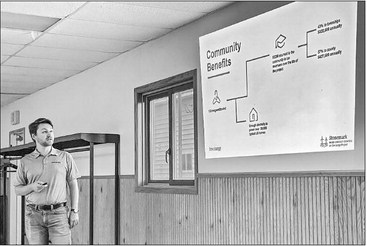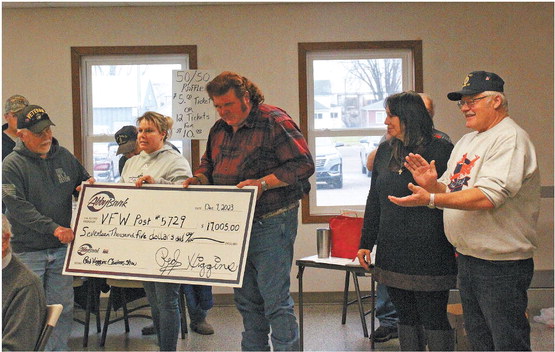Invenergy provides details on wind project


By Kevin O’Brien
Representatives from Invenergy, a Chicago-based renewable energy company, were invited to the town of Wien’s monthly board meeting Monday to speak about a proposed wind farm that promises to produce 150 megawatts of electricity and generate $750,000 in annual tax revenue for the town and Marathon County.
Dylan Lennie, the project manager for what’s been dubbed the Stonemark Wind project, told town officials and residents that over 65 local families have signed leases with the company over the past two years, covering a total of 14,000 acres. Once the project is completed, however, he said the total number of turbines will be between 25 and 35, taking up less than 100 total acres across multiple townships in Marathon County.
“The on-the-ground impact is pretty minimal when it finally gets up and running,” he said, noting that each turbine takes up about a half-acre.
Lennie said Invenergy has been developing the project since 2022, starting by signing up landowners under confidential agreements that include payments in exchange for the company installing and accessing wind turbines on their land. When asked about the height of the turbines, he said they will be between 550 and 600 feet tall, de-
See INVENERGY/ Page 5 Invenergy
Continued from page 1
pending on the amount of electricity to be generated.
Cal Tackes, Wien’s town chairman, said he invited Lennie and other Invenergy representatives to do a presentation after speaking with them privately about their proposal. Before Monday’s meeting, he provided Lennie with a list of 16 questions to answer in front of the board and town residents, who were also given a brief opportunity to ask their own questions.
“Just remember, folks, this is a meeting where you’re gathering information,” he told the audience. “It is not a gripe session, OK? We’re not here to abuse the people who are sharing information with us.”
Invenergy is one of several renewable energy companies looking to establish industrial wind and solar operations in western Marathon County and eastern Clark County, which has resulted in a public backlash.
Lennie said Invenergy has 20 years of experience building wind energy operations, having established its first project in 2004, with a 117 total projects now either online or in development.
Invenergy recently opened an office downtown Marathon City, but the company eventually plans to build an operations and maintenance building with up to six full-time people in charge of running the facilities, he said.
Lennie said the 150 megawatt project will produce enough electricity to power up to 39,000 homes on an annual basis, and as part of its arrangement with the local community, Invenergy will invest an estimated total of $72 million into the local economy over the life of the project through tax revenues, payments to landowners and job creation.
The town will receive 43 percent, $322,500, of the annual taxes paid by the utility through the state’s shared revenue program, with the remaining 57 percent, $427,500, going to the county, he said.
Tackes confirmed with Lennie that the tax revenue won’t start coming in until the after project is up and running, which is scheduled to take place in 2029 under Invenergy’s timeline. Based on that schedule, the project is currently still in the development stage, with construction slated for 2027 and 2028.
Lennie said the construction phase will require the hiring of about 200 union workers, and during the full 30-year life of the project, landowners are expected to earn a total $43 million under their lease agreements.
The state’s setback requirements, spelled out in PSC 128, establish that each wind turbine must be at least 1,250 feet (or 3.1 times the maximum height of the turbine blade) away from any nonparticipating resident or occupied community building. However, Lennie stressed that these are the minimum setbacks, and the actual placement of the turbines will be based a variety of factors that will be determined by several pre-construction studies.
The pre-construction studies will examine multiple issues, such as migratory birds, wetlands and subsoil composition, Lennie said.
“We are very, very early on in this process,” he said.
Questions, concerns linger
Lennie spent about a half-hour answering the 16 questions posed by Tackes and addressing those asked by audience members, who quizzed him about everything from PSC regulations to emergency training in the event that a wind turbine catches on fire.
One of the first issues he addressed was Invenergy’s liability if town and county roads are damaged during construction or maintenance operations. Lennie said the company’s local operating contract is “a road use agreement on steroids” that goes beyond the PSC requirements and makes Invenergy responsible for any road damages.
“If that $750,000 a year in tax revenue disappears, it holds us accountable to replace that payment out of our pocket,” he said.
In response to a question about decommissioning the project after it ceases operation, Lennie said Invenergy is required to post a bond or letter of credit to cover decommissioning costs after 15 years of operation.
Lennie said local residents will have plenty of opportunities to raise questions and express concerns about the project, including a public comment period required as part of Invenergy’s permit application process through the Public Service Commission.
Also, as part of the permitting process, Lennie said “thousands and thousands of pages” worth of studies will need to be sub-
See INVENERGY/ Page 6
ENERGY PRESENTATION - Dylan Lennie of Invenergy goes through the “community benefits” of the proposed Stonemark Wind project planned for western Marathon County during a presentation at the town of Wien Monday.
STAFF PHOTO/KEVIN O’BRIEN Invenergy
Continued from page 5
mitted by Invenergy, which will also be voluntarily following land-based wind energy guidelines set by the U.S. Fish and Wildlife Service.
Still, concerns lingered about the safety of the wind turbines once they’re in place.
Trine Spindler, a member of the Farmland First group opposing wind and solar operations, said she spoke to the local fire chief, who said his department does not have the training or equipment needed to fight a wind turbine fire.
“What are you guys doing to do to keep us safe, living next to these things, considering our local fire and rescue can’t handle it?” she asked.
Lennie said Invenergy representatives have “every intention” of meeting with local firefighters and EMTs to arrange training opportunities, and he noted that the company’s own staff are required to complete 65 hours of safety training every year and conduct monthly drills.
Spindler, however, said Invenergy is not going to pay for local firefighters to purchase the necessary equipment, but Lennie said that’s where the $750,000 in annual taxes comes in.
Several of the questions from both Tackes and audience members dealt with the PSC 128 regulations, which have not been updated since 2012 despite increasing wind turbine heights and other changes in the technology. Lennie said Wisconsin’s 15-member Wind Siting Council recently released a report based on their review of 59 peer-reviewed studies, and a majority of the member recommended no changes in the state’s regulations.
When asked what would happen if the PSC 128 rules were to change before Invenergy’s turbines are erected, Lennie said “the project would have to adhere to those changes.”
Rep. Donna Rozar pointed out that, ultimately, elected representatives in Madison have the power to set the state rules.
“The state legislature overrules the Public Service Commission,” she said. “So, if some laws were made, the Public Service Commission would have to abide by those state statutes.”



